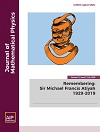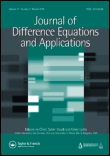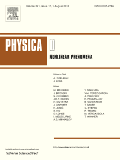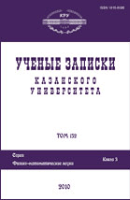
REGULAR & CHAOTIC DYNAMICS
metrics 2024
Unraveling Complexities in Applied Mathematics
Introduction
Regular & Chaotic Dynamics, published by PLEIADES PUBLISHING INC, is an esteemed journal that serves as a vital platform for disseminating cutting-edge research in the fields of applied mathematics, mathematical physics, and various interdisciplinary realms. With its ISSN 1560-3547 and E-ISSN 1468-4845, the journal features a diverse array of articles that delve into the dynamic systems and the intricacies of non-linear phenomena, offering insights invaluable to researchers and professionals alike. Since its launch in 1998, it has established itself as a significant resource, holding impressive rankings in Scopus that highlight its influence, including Q2 and Q3 quartile designations across multiple categories. While the journal is not open access, its rigorous peer-review process ensures high-quality publications that advance the discourse within the scientific community, making it an essential read for scholars dedicated to exploring the complexities of dynamical systems.
Metrics 2024
 0.38
0.38 0.80
0.80 0.90
0.90 40
40Metrics History
Rank 2024
Scopus
IF (Web Of Science)
JCI (Web Of Science)
Quartile History
Similar Journals

Advances in Mathematical Physics
Empowering Research with Cutting-Edge DiscoveriesAdvances in Mathematical Physics is a premier open-access journal published by HINDAWI LTD, dedicated to the dissemination of research in the fields of applied mathematics and physics. With its ISSN 1687-9120 and E-ISSN 1687-9139, this journal has been a vital platform for innovative studies since its inception in 2009, fostering a collaborative environment for researchers and professionals alike. The journal features a wide range of topics, including but not limited to mathematical models, computational physics, and interdisciplinary applications, thus attracting a diverse readership. Ranked in the Q3 quartile for both Applied Mathematics and Physics and Astronomy, it serves as a significant resource for academics looking to explore cutting-edge developments and theoretical advancements. With an emphasis on open accessibility, Advances in Mathematical Physics ensures that research findings are readily available to the global academic community, leveling the playing field for emerging scholars and seasoned researchers. By consistently showcasing high-quality manuscripts, the journal contributes substantially to the fields of mathematics and physics, encouraging scholarly dialogue and advancing knowledge across a myriad of applications.

JOURNAL OF MATHEMATICAL PHYSICS
Exploring the intersection of theory and application in physics.Welcome to the JOURNAL OF MATHEMATICAL PHYSICS, a distinguished publication dedicated to the burgeoning fields of mathematical physics and statistical and nonlinear physics, published by AIP Publishing. Established in 1960, the journal continually showcases cutting-edge research and theoretical advancements that drive the understanding of complex systems and mathematical formulations within physics. With an impressive Scopus ranking of #38 in Mathematical Physics and #39 in Statistical and Nonlinear Physics, the journal is recognized for its vital contributions to the academic community, achieving a solid Q2 quartile ranking in both categories for 2023. While not an open-access journal, it remains a critical resource for researchers, professionals, and graduate students seeking insights into rigorous mathematical methods and their applications in physical sciences. Engage with the finest research as we converge toward new frontiers from 1960 to 2024, fostering academic collaboration and innovation.

Journal of Dynamics and Differential Equations
Charting New Paths in Differential Equations ResearchJournal of Dynamics and Differential Equations, published by SPRINGER, is a premier academic journal dedicated to advancing the understanding of dynamic systems and their mathematical foundations. Operating since its inception in 1989, the journal has become a vital resource for researchers and practitioners in the field, boasting a commendable Q1 ranking in the Analysis category as of 2023 and ranking #39 out of 193 journals in Mathematics Analysis on Scopus, placing it in the 80th percentile. While it maintains a traditional subscription model, its substantial contributions to the mathematics community—measured by a robust impact and adherence to high academic standards—make it essential reading for those engaged in differential equations and dynamical systems. The journal covers a broad scope of theoretical and applied research, positioning itself as a cornerstone for innovative studies and discussions, and ensuring its relevance to both contemporary and future mathematical inquiries.

JOURNAL OF STATISTICAL PHYSICS
Unraveling the complexities of Mathematical Physics since 1969.The Journal of Statistical Physics, published by Springer, is a premier academic journal that has made significant contributions to the fields of Mathematical Physics and Statistical and Nonlinear Physics since its inception in 1969. With a strong reputation reflected in its 2023 rankings—placing it in Q2 of both categories and achieving an impressive Scopus rank of #22 in Mathematical Physics and #25 in Statistical and Nonlinear Physics—this journal serves as a vital platform for researchers, professionals, and students. The impact factor of the journal underscores its importance in disseminating cutting-edge research and theoretical developments. Authors are invited to submit original research articles that explore the intricate complexities of statistical mechanics, quantum physics, and related disciplines, fostering deep insights and academic discourse. Although the journal does not currently offer open access, its robust editorial standards and commitment to advancing knowledge make it an essential resource for those engaged in these dynamic fields.

JOURNAL OF DIFFERENCE EQUATIONS AND APPLICATIONS
Pioneering research in difference equations and their real-world impact.The Journal of Difference Equations and Applications, published by Taylor & Francis Ltd, is a vital resource for researchers and professionals in the fields of algebra, analysis, and applied mathematics. With its ISSN 1023-6198 and E-ISSN 1563-5120, this esteemed journal aims to foster the development and understanding of difference equations and their applications across various mathematical contexts. Since its inception in 1995, the journal has consistently ranked within the Q2 category for Algebra and Number Theory, Analysis, and Applied Mathematics, showcasing its high-impact contributions to the field. The journal is particularly noteworthy for its rigorous peer-review process and commitment to advancing mathematical knowledge and research. Although it is not open access, it remains accessible through various institutional subscriptions. With a focus on innovative methodologies and interdisciplinary approaches, the Journal of Difference Equations and Applications is essential reading for those looking to stay at the forefront of mathematical research and applications.

Journal of Dynamical Systems and Geometric Theories
Fostering Insightful Discourse in Geometric TheoriesJournal of Dynamical Systems and Geometric Theories, published by TARU Publications, is a prominent platform dedicated to advancing knowledge in the fields of dynamical systems and geometric theories. With an ISSN of 1726-037X and an E-ISSN of 2169-0057, this journal serves as a vital resource for researchers, professionals, and students who are keen on exploring the complexities of mathematical models and their applications in various scientific disciplines. Though currently listed as non-open access, the journal provides robust, peer-reviewed content that is essential for fostering innovative research and development. Situated in New Delhi, India, the Journal of Dynamical Systems and Geometric Theories is committed to disseminating high-quality scholarly articles that address both theoretical and practical issues related to dynamical systems, enhancing understanding and stimulating further academic discourse. To learn more about submission guidelines and access options, please visit the journal’s official webpage.

Izvestiya Vysshikh Uchebnykh Zavedeniy-Prikladnaya Nelineynaya Dinamika
Connecting Scholars through Open Access DiscoveriesIzvestiya Vysshikh Uchebnykh Zavedeniy-Prikladnaya Nelineynaya Dinamika, published by Saratov State University, is a distinguished open-access journal that has been contributing to the fields of Applied Mathematics and Physics since its inception in 2005. With an ISSN of 0869-6632 and E-ISSN 2542-1905, this journal fosters the dissemination of innovative research in nonlinear dynamics and statistical physics. Recognized within the academic community, it holds a Q3 ranking in the categories of Applied Mathematics, Physics and Astronomy (miscellaneous), and Statistical and Nonlinear Physics as of 2023. Despite facing competitive environment challenges, with Scopus ranks positioning it in the lower percentiles, the journal remains an important platform for scholars aiming to share insightful findings and theoretical advancements with a global audience. Based in the Russian Federation, it transitioned to an open-access model in 2020, enhancing accessibility and ensuring that cutting-edge research reaches those who can benefit from it most. The journal aspires to continue its trajectory of fostering high-quality scholarship through rigorous peer review and collaboration across disciplines.

PHYSICA D-NONLINEAR PHENOMENA
Pioneering Research in Nonlinear Dynamics Since 1980PHYSICA D-NONLINEAR PHENOMENA, published by Elsevier, serves as a leading academic journal at the forefront of the fields of Applied Mathematics, Condensed Matter Physics, Mathematical Physics, and Statistical and Nonlinear Physics. With an impressive track record since its inception in 1980, this journal has maintained a distinguished presence, noted for its Q1 ranking in multiple categories in 2023, showcasing its impact and relevance in the scientific community. The journal's commitment to advancing knowledge is reflected not only in its rigorous peer-reviewed articles but also through its high visibility and accessibility, aiding researchers, professionals, and students in staying abreast of the latest developments in nonlinear phenomena. Located in Amsterdam, Netherlands, PHYSICA D-NONLINEAR PHENOMENA is essential for those seeking to explore innovative research and contribute to groundbreaking discoveries in the realm of nonlinear dynamics.

Uchenye Zapiski Kazanskogo Universiteta-Seriya Fiziko-Matematicheskie Nauki
Exploring the frontiers of scientific inquiry.Uchenye Zapiski Kazanskogo Universiteta-Seriya Fiziko-Matematicheskie Nauki, published by Kazan Federal University, is an esteemed open-access journal from the Russian Federation dedicated to the fields of physics and mathematics. Since its transition to open access in 2005, this journal has aimed to disseminate high-quality research across various sub-disciplines including applied mathematics, modeling and simulation, and general physics and astronomy. With an ISSN of 2541-7746 and an E-ISSN of 2500-2198, it serves as a vital platform for researchers, professionals, and students seeking to advance their understanding and contribute to these critical scientific areas. Despite its current ranking in the fourth quartile across several categories—reflecting its development phase—the journal is progressively enhancing its scope and reach. The convergence of ideas and innovations represented in its publications is essential for fostering collaboration and growth in the scientific community, particularly as it prepares to extend its influence through 2024 and beyond.

NONLINEAR DYNAMICS
Connecting Researchers in the Realm of Nonlinear EngineeringNONLINEAR DYNAMICS is an esteemed academic journal published by SPRINGER, focusing on a diverse range of topics within the fields of Aerospace Engineering, Applied Mathematics, Control and Systems Engineering, Electrical and Electronic Engineering, Mechanical Engineering, and Ocean Engineering. Since its inception in 1990, this journal has become a premier platform for disseminating cutting-edge research and innovative methodologies from both theoretical and practical perspectives. With a high impact factor and ranked in the Q1 quartile across several engineering and mathematics categories, NONLINEAR DYNAMICS is recognized for its significant contribution to advancing knowledge and technology in nonlinear phenomena. Researchers and professionals are encouraged to engage with this journal to publish their findings and stay at the forefront of developments. Although it does not offer open access options, the journal ensures rigorous peer review, enhancing the credibility and visibility of published work.